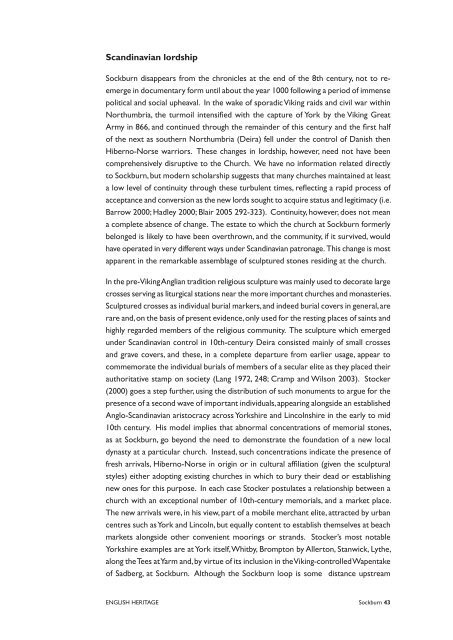Sockburn Hall, Darlington: an archaeological ... - English Heritage
Sockburn Hall, Darlington: an archaeological ... - English Heritage
Sockburn Hall, Darlington: an archaeological ... - English Heritage
You also want an ePaper? Increase the reach of your titles
YUMPU automatically turns print PDFs into web optimized ePapers that Google loves.
Sc<strong>an</strong>dinavi<strong>an</strong> lordship<br />
<strong>Sockburn</strong> disappears from the chronicles at the end of the 8th century, not to re-<br />
emerge in documentary form until about the year 1000 following a period of immense<br />
political <strong>an</strong>d social upheaval. In the wake of sporadicViking raids <strong>an</strong>d civil war within<br />
Northumbria, the turmoil intensified with the capture of York by the Viking Great<br />
Army in 866, <strong>an</strong>d continued through the remainder of this century <strong>an</strong>d the first half<br />
of the next as southern Northumbria (Deira) fell under the control of D<strong>an</strong>ish then<br />
Hiberno-Norse warriors. These ch<strong>an</strong>ges in lordship, however, need not have been<br />
comprehensively disruptive to the Church. We have no information related directly<br />
to <strong>Sockburn</strong>, but modern scholarship suggests that m<strong>an</strong>y churches maintained at least<br />
a low level of continuity through these turbulent times, reflecting a rapid process of<br />
accept<strong>an</strong>ce <strong>an</strong>d conversion as the new lords sought to acquire status <strong>an</strong>d legitimacy (i.e.<br />
Barrow 2000; Hadley 2000; Blair 2005 292-323). Continuity, however, does not me<strong>an</strong><br />
a complete absence of ch<strong>an</strong>ge. The estate to which the church at <strong>Sockburn</strong> formerly<br />
belonged is likely to have been overthrown, <strong>an</strong>d the community, if it survived, would<br />
have operated in very different ways under Sc<strong>an</strong>dinavi<strong>an</strong> patronage. This ch<strong>an</strong>ge is most<br />
apparent in the remarkable assemblage of sculptured stones residing at the church.<br />
In the pre-VikingAngli<strong>an</strong> tradition religious sculpture was mainly used to decorate large<br />
crosses serving as liturgical stations near the more import<strong>an</strong>t churches <strong>an</strong>d monasteries.<br />
Sculptured crosses as individual burial markers,<strong>an</strong>d indeed burial covers in general,are<br />
rare <strong>an</strong>d,on the basis of present evidence,only used for the resting places of saints <strong>an</strong>d<br />
highly regarded members of the religious community. The sculpture which emerged<br />
under Sc<strong>an</strong>dinavi<strong>an</strong> control in 10th-century Deira consisted mainly of small crosses<br />
<strong>an</strong>d grave covers, <strong>an</strong>d these, in a complete departure from earlier usage, appear to<br />
commemorate the individual burials of members of a secular elite as they placed their<br />
authoritative stamp on society (L<strong>an</strong>g 1972, 248; Cramp <strong>an</strong>d Wilson 2003). Stocker<br />
(2000) goes a step further, using the distribution of such monuments to argue for the<br />
presence of a second wave of import<strong>an</strong>t individuals,appearing alongside <strong>an</strong> established<br />
Anglo-Sc<strong>an</strong>dinavi<strong>an</strong> aristocracy across Yorkshire <strong>an</strong>d Lincolnshire in the early to mid<br />
10th century. His model implies that abnormal concentrations of memorial stones,<br />
as at <strong>Sockburn</strong>, go beyond the need to demonstrate the foundation of a new local<br />
dynasty at a particular church. Instead, such concentrations indicate the presence of<br />
fresh arrivals, Hiberno-Norse in origin or in cultural affiliation (given the sculptural<br />
styles) either adopting existing churches in which to bury their dead or establishing<br />
new ones for this purpose. In each case Stocker postulates a relationship between a<br />
church with <strong>an</strong> exceptional number of 10th-century memorials, <strong>an</strong>d a market place.<br />
The new arrivals were, in his view, part of a mobile merch<strong>an</strong>t elite, attracted by urb<strong>an</strong><br />
centres such asYork <strong>an</strong>d Lincoln, but equally content to establish themselves at beach<br />
markets alongside other convenient moorings or str<strong>an</strong>ds. Stocker’s most notable<br />
Yorkshire examples are at York itself,Whitby, Brompton by Allerton, St<strong>an</strong>wick, Lythe,<br />
along theTees atYarm <strong>an</strong>d,by virtue of its inclusion in theViking-controlledWapentake<br />
of Sadberg, at <strong>Sockburn</strong>. Although the <strong>Sockburn</strong> loop is some dist<strong>an</strong>ce upstream<br />
ENGLISH HERITAGE <strong>Sockburn</strong>

















